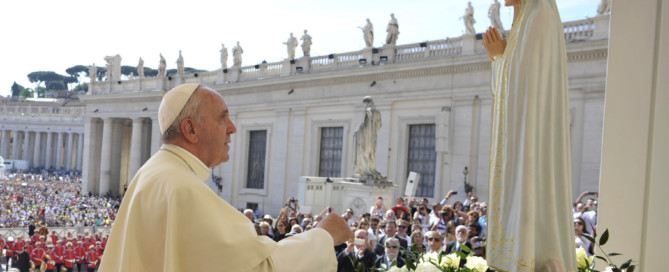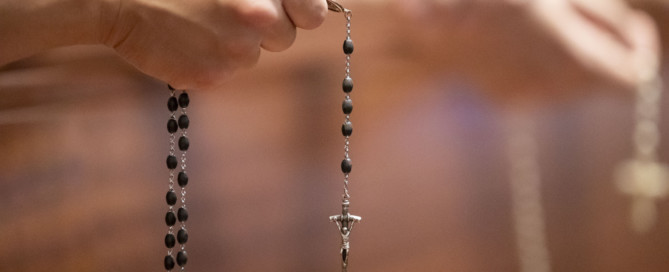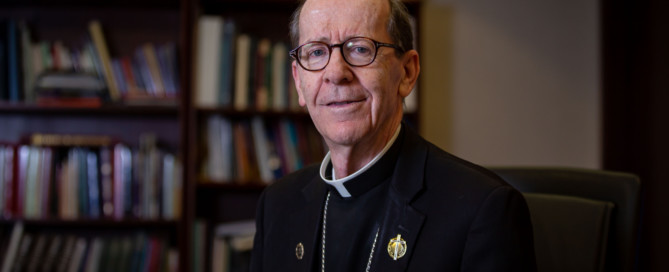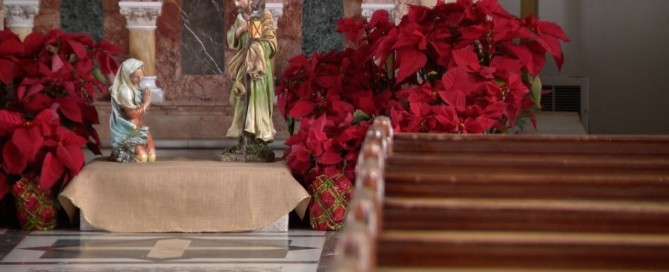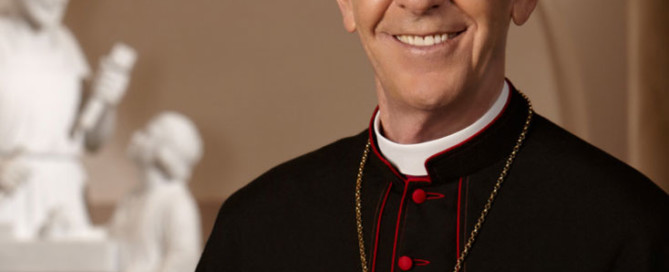Welcome to Our New Website!
Pope Francis to Consecrate Russia and Ukraine to the Immaculate Heart of Mary March 25, 2022
Statement on Pope Francis’ Consecration of Russia and Ukraine to the Immaculate Heart of Mary
March 25, 2022
Updated: 3/22/22
Bishop Olmsted and Bishop Nevares invite all people of faith to join Pope Francis on Friday, March 25, 2022, the Solemnity of the Annunciation, in prayers of Consecration for Russia and Ukraine to the Immaculate Heart of Mary. The consecration will take place at 5:00 p.m. Rome time and 9:00 a.m. Arizona time.
The faithful are encouraged to attend Mass, spend time in prayer, and watch the live stream Consecration with Pope Francis. Some other suggestions for the faithful:
- The Holy Father is inviting all priests around the world to join him in Consecration on Friday, March 25. He will offer the Act of Consecration in the context of a Celebration of Penance to be held at Saint Peter’s Basilica at 5:00 p.m. Rome time, 9:00 a.m. Phoenix time. The Act itself will take place about 6:30 p.m. Rome time, 10:30 a.m. Phoenix time.
- The Holy Father is asking that people recite the prayer of consecration at some point throughout the day, as they see fit in their parish/school/community.
- Bishop Olmsted will celebrate Mass on the Solemnity of the Annunciation at 8:00 a.m. at Ss. Simon and Jude Cathedral, along with the school community.
- Bishop Nevares will celebrate Mass on the Solemnity of the Annunciation at Our Lady of Perpetual Help in Glendale at 8 a.m., along with the school community.
- We are encouraging our Catholic Schools to unite in prayer with the students during the 9 a.m. hour.
- If you are unable to attend a parish event, pause at the 9:00 a.m. hour and offer a period of silence, a decade of the Rosary and/or some other form of prayer.
- Parishes may ring their bells at 9:00 a.m. to announce the consecration and invite the community to participate in the prayer. Parishes may wish to promote ahead of time to their communities the purpose of the bell ringing via digital, print, and outdoor media, if possible, e.g., “Join us in prayer for peace in the Ukraine when the bells ring at 9 a.m., 3/25/22.”
- Spend time in prayer with the Blessed Sacrament.
- Unite in an act of charity and service. As a means of continued support, an online donation option towards the Ukrainian Catholic Archeparchy in Philadelphia is available on the Diocese of Phoenix website at https://dphx.org/ukraine/
Brett Meister named Director of Communications
Brett Meister named Director of Communications
PHOENIX (March 10, 2022) — The Roman Catholic Diocese of Phoenix is pleased to announce that it has named Brett Meister its new Director of Communications. He joins the Catholic Diocese of Phoenix after nearly three decades leading communications and goodwill outreach for global sports organizations, including most recently the world-famous Harlem Globetrotters.
“We are grateful to have Brett as the newest member of the leadership team and look forward to his professional assistance in the efforts of communicating and sharing the beauty and truth of our Catholic faith,” said Father Fred Adamson, Vicar General and Moderator of the Curia for the Diocese of Phoenix.
During his 23-year tenure with the Globetrotters, Meister traveled with the team to more than 30 countries around the world as the organization fulfilled its role as global ambassadors of goodwill, including historic visits to Iraq, Afghanistan, North Korea and Cuba. Meister also accompanied the team to poverty-stricken regions within Honduras, Uzbekistan, Mozambique, Lithuania and Estonia, and personally secured two visits to the Vatican for the Globetrotters, meeting Pope John Paul II (2000) and Pope Francis (2015).
“I am grateful and excited to come work with an outstanding group of talented people who lead the Diocese of Phoenix,” said Meister. “I look forward to working with the parishioners, the clergy and the great people across the Diocese, along with Bishop Olmsted and his leadership team to fulfill the great mission of the Catholic faith in Arizona.”
Before joining the Globetrotters in 1997, Meister served as VP of Communications for the Continental Basketball Association in St. Louis, where he worked as the league’s main spokesperson and liaison to the National Basketball Association and USA Basketball. His international experience also included work on the USOC press information team at the 1996 Summer Olympic Games and serving as assistant venue press manager for the 2013 World Baseball Classic. He began his professional career as a television reporter and news editor at KTIV-TV (NBC) in Sioux City, Iowa.
Meister’s faith background has included many facets of the Catholic Church, including his longtime membership in the Knights of Columbus, where he is currently a Fourth-Degree member. A native of Marcus, Iowa, he is a graduate of Briar Cliff University, a Catholic school located in Sioux City, and he is an accomplished photographer. Meister has two adult daughters and four grandchildren, who reside in Mesa, Arizona.
Background Information
The Roman Catholic Diocese of Phoenix was established Dec. 2, 1969, by Pope Paul VI. Led by the Most Rev. Thomas J. Olmsted, more than 1.1 million Catholics make this diverse, vibrant and faith-filled diocese their home, including 94 parishes and 23 missions. Nearly 15,000 students attend one of the 29 Catholic elementary schools, seven high schools and 29 preschools in the Diocese of Phoenix. Learn more about the Catholic Church at dphx.org.
Statement on crisis in Ukraine
Statement on crisis in Ukraine
Bishop Olmsted joins the Holy Father in asking the faithful to pray and fast for peace in the Ukraine. Our Lady, Queen of Peace, pray for us.
Bishop Olmsted at the University of Mary Desert Rose Social and Dinner
Bishop Olmsted at the University of Mary Desert Rose Social and Dinner
Following is the prepared text for Bishop Olmsted’s remarks at the University of Mary Desert Rose Social and Dinner.
February 11, 2022
Thank you for this honor. Above all, I am grateful for the strong leadership of Msgr. Shea and the good work of the University of Mary here, in North Dakota, and beyond.
In her book “Primal Screams,” Mary Eberstadt argues that the sexual revolution created identity politics. This occurred because, for hundreds of years when a person was asked, “who are you?”, their response was rooted in their faith and family, “I am a member of this church, and these are my parents…” But with the breakdown of the family due to the corrosive nature of the sexual revolution and the abandonment of faith, we see in the rising number of those who identify with no religious affiliation, people now cling to a secondary identity (gender, sex, or ethnicity) as a primary one.
“Why?” Eberstadt asks, “Why, when you challenge someone’s membership in the LGBTQ community, is the response so vitriolic?” Because for them, with the experience of being unmoored from the traditional pillars of faith and family (and the attendant pain and confusion that accompanies it), they now root their identity in this community and will fight you as if their survival depended on it. When you don’t know who you are and you find something that gives you a feeling of belonging, you feel as if your value as a person is dependent on membership in that community. What is needed is a much more solid foundation on which to build your identity.
Enter Catholic schools.
This evening I would like to share some brief remarks of how Catholic education seeks to answer the most fundamental question of identity and can be a salve to young people growing up in a morass of confusion and pain.
My first point is that Kerygma is key. Kerygma, the Greek word for “proclamation,” refers to the initial pronouncement of the Good News of salvation found in Jesus Christ. As Pope Francis remarked in Evangelli Gaudium,
“We have rediscovered the fundamental role of the first announcement or kerygma, which needs to be the center of all evangelizing activity and all efforts at Church renewal… On the lips of the catechist the first proclamation must ring out over and over: “Jesus Christ loves you; he gave his life to save you; and now he is living at your side every day to enlighten, strengthen, and free you” (#163, emphasis added).
A Catholic school, whether a grade school, high school, or university must have the Kerygma as its center if it desires to be an instrument of renewal in our culture. The best way for a young person to know “who they are” is to know “whose they are:” That God loves them and has a plan for their life, has died for any and all sin that would destroy that plan, and seeks to bring His redemptive healing to any places in their heart wounded by our culture of counterfeit love. Jesus offers to young people the key to discovering their authentic identity. Once a person knows the love of God poured into his or her heart they realize that there is no true personal authenticity outside the authority of God (Romans 5:5). God alone can tell young persons who they are and for what He made them.
This fundamental mission must constantly be tended so that it remains central. One possible idol for Catholic school is the “idol of enrollment.” The implicit belief that if a Catholic school is going up in enrollment it necessarily follows that it is doing well and if enrollment is going down it necessarily follows the school is not doing well. But a Catholic school should not be judged by how many students it graduates, but how well those graduates were formed to be missionary disciples of Jesus. Considering Our Lord spent an enormous amount of time with His twelve disciples (and among them even more intentional time with Peter, James, and John) it should teach us that it is better to graduate a smaller number of well-formed students than a larger number of students who have been mediocrely formed.
Secondly, out of this Kerygmatic mission, the Catholic school should form authentic community. This communion among its members is nothing less than the communion borne out of living contact with the Holy Spirit with Christ at its center. A Catholic community is one of conversion, one in which people can speak to the real difference Jesus makes in their life. This community is rooted not in our secondary identities of race, gender, or sex, but in our shared communion of being made in God’s image and likeness, redeemed by Christ, and destined for supernatural life.
To safeguard this community, a Catholic school should be very judicious and appropriately critical of the role technology plays in the education of young people. One of the central mysteries of our faith is the incarnation, the belief that God “took flesh and dwelt among us” (John 1:14). If the God of the Universe drew close to us through taking on a human nature, what message do we send to young people when so much of their education is mediated through screens? This is not about being anti-technology, but about letting a solid Catholic anthropology, which takes the incarnation seriously, drive our educational decisions rather than letting technology lead in discussions of Catholic pedagogy. Young people need real human connection, and contact with real things.
Additionally, because, as Catholics, we know that every person is made in God’s image and likeness, one God who is a communion of three persons and “an eternal exchange of love,” we know that we are made by love, to love, and for love (CCC #221). We experience this love first in our families—our primary community of love. But acknowledging the serious ruptures young people experience in this most foundational of communities, it is important that Catholic schools, from grade schools to universities, partner with solid Catholic counselors to help heal our culture at its roots, that is, in families. In Family Systems therapy, one of their key mantras is, “the problem is not the problem, the problem is a symptom of the problem.” In other words, when a young person is manifesting problematic behavior at school, a person trained in Family Systems therapy would assume there is a dysfunction in their family system, which, if healed, will lead to a resolution of the problematic behavior manifested in this child. Knowing what we know about being made in the image and likeness of a trinitarian God, this approach is commensurate with a Catholic understanding of the human person. Grade schools can partner with Catholic counseling centers to offer to struggling families the healing they need, while Catholic universities can provide counseling services to college students where their pain can be validated and healed.
Lastly, Catholic education can impart to its students both wisdom and virtue. Wisdom is to know the truth, and virtue is to put it into practice. Perhaps the biggest lie in our culture is that God is an enemy to our freedom, that He somehow circumscribes or limits the potential of the human person when He is worshiped and adored. Catholic education forms young people to know true freedom found in Christ. As the Catechism reminds us, “The goal of a virtuous life is to become like God” (CCC #1063 – St. Gregory of Nyssa). God is not an enemy to our freedom and joy; He is their foundation and principle. As the Second Vatican Council warned, “When God is forgotten, …the creature itself grows unintelligible” (Gaudium et Spes #36). If we desire young people to rediscover who they are, Catholic education has a decisive role to play.
Matthew’s Gospel begins with the genealogy of Jesus. It is not a list of perfect people… it has Rahab the prostitute, Jacob the trickster, Moses the murderer, David the adulterer, and so on. No one gets to pick the family they are born into, but Jesus could; and yet He chose this one. Why? Because He came to save it. Despite the brokenness so many young people experience and the subsequent confusion and pain that follow, Jesus desires to bring them healing and peace. May our Catholic schools be places of healing and renewal as they proclaim the Gospel with conviction, form authentic community, and equip their graduates in wisdom and virtue. The only One who deserves all of a young person’s heart is the One who made it.
Thank you.
A Call for the Faithful to Unite in Spiritual Warfare
A Call for the Faithful to Unite in Spiritual Warfare
January 14, 2022
Updated February 7, 2022
We are aware that there is conflicting information being spread on social media and websites regarding the Diocese’s stance on the Satanic Conference that will take place in Scottsdale next weekend.
Bishop Olmsted reiterates his desire that we refrain from participating in any public demonstration or protest. He continues to invite the faithful to unite in spiritual warfare through prayer, fasting and participation in the Sacraments. These are the most effective spiritual weapons against Satan’s futile attempt at sowing division and confusion in our midst.
As St. Paul reminds the early Christians of Ephesus, “Put on the armor of God so that you may be able to stand firm against the tactics of the devil. For our struggle is not with flesh and blood but with the principalities, with the powers, with the world rulers of this present darkness, with the evil spirits in the heavens” (Ephesians 6:11-12). This is why our main weapons against Satan are prayer and fasting, rather than works against human beings.
Please join Bishop Olmsted in increased prayer and sacrifice in the following concrete ways:
- Attend public Eucharistic adoration opportunities at your parish
- Pray novenas and prayers to the Blessed Virgin and the Saints, especially the Prayer of St. Michael after Masses
- Increase your efforts to attend weekday Masses
- Fast
- Make sacrifices of reparation for sinners
Community acts of reparation:
- The Catholic Men’s Fellowship of Phoenix Men’s Conference will begin with adoration of the Blessed Sacrament and prayers of reparation led by Bishop Olmsted. Men can register here to attend.
- Join Our Lady of Perpetual Help, Scottsdale, for a Holy Hour beginning at 3 p.m. on February 9, 10, and 11. The parish community will pray the Chaplet of Divine Mercy, the Holy Rosary, the prayer to St. Michael, and spend time in quiet adoration before the Lord.
- Join Holy Cross, Mesa, for Stations of the Cross on January 28, February 4, and February 11 beginning at 6 p.m. and followed by adoration of the Blessed Sacrament to make reparation to the Sacred Heart.
Historic South Phoenix Church will reopen for Christmas
PHOENIX — The church community of Sacred Heart Catholic Church is a testament to the power of faith, hard work, and sacrifice. Closed and boarded up 36 years ago, Sacred Heart and the spirit it personifies never wavered. So on Christmas Eve morning, volunteers cleaned windows and washed the floor in advance of the late afternoon Mass.
“Over the years they’ve been very clear this church is part of their history and so I want them to own it and enjoy it,” said Father Paul Sullivan, Pastor of Sacred Heart.
In the mid-1980s the Phoenix City Council had other plans, bulldozing the neighborhood and boarding up the church to make way for the expansion of Sky Harbor Airport. In later years the city council tried to demolish the church.
“I remember the day in 2017 when the city council voted that the community would lose their church,” Father Sullivan said.
But it never happened.
Letter from Bishop Olmsted on the Responsa Ad Dubia regarding Traditionis Custodes
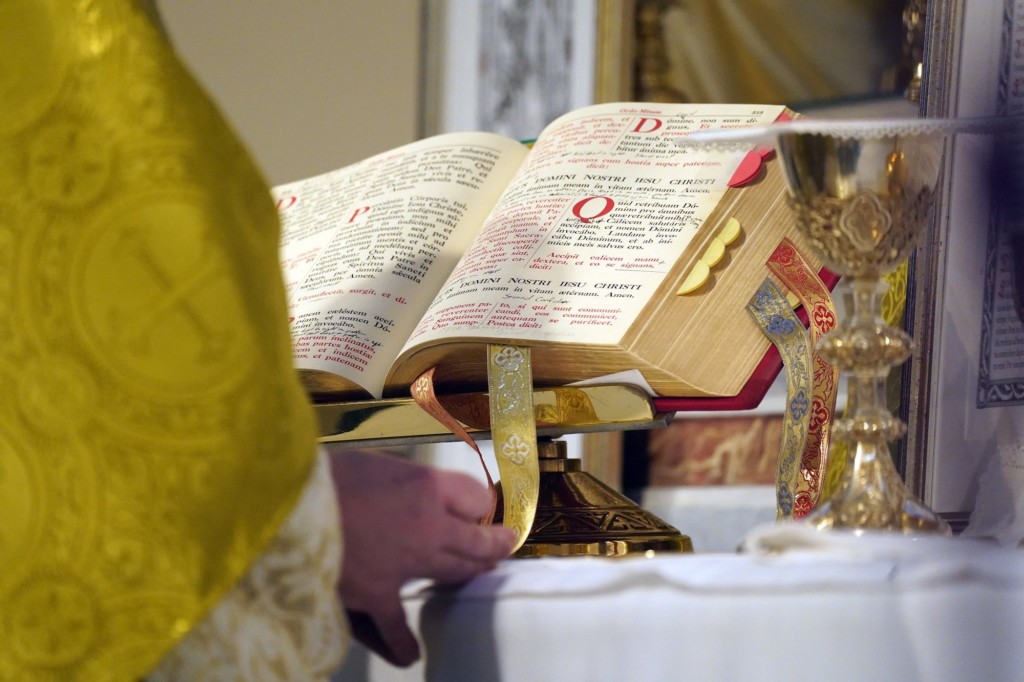
A sacramentary is seen on the altar during a traditional Tridentine Mass July 18, 2021, at St. Josaphat Church in the Queens borough of New York City. The Sunday Latin Mass has a dedicated following, drawing more than 150 people from Queens and neighboring counties, in addition to southwestern Connecticut and northern New Jersey. (CNS photo/Gregory A. Shemitz)

